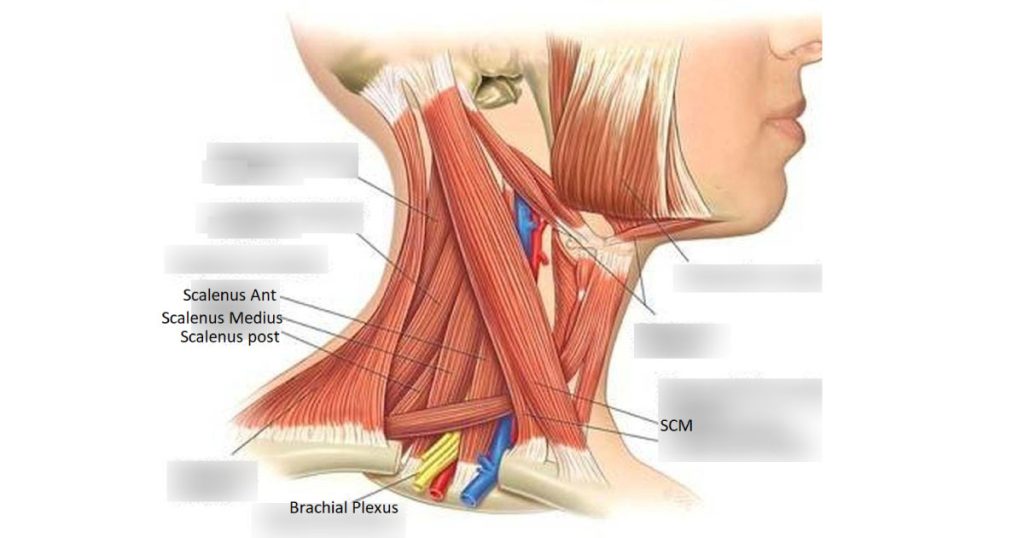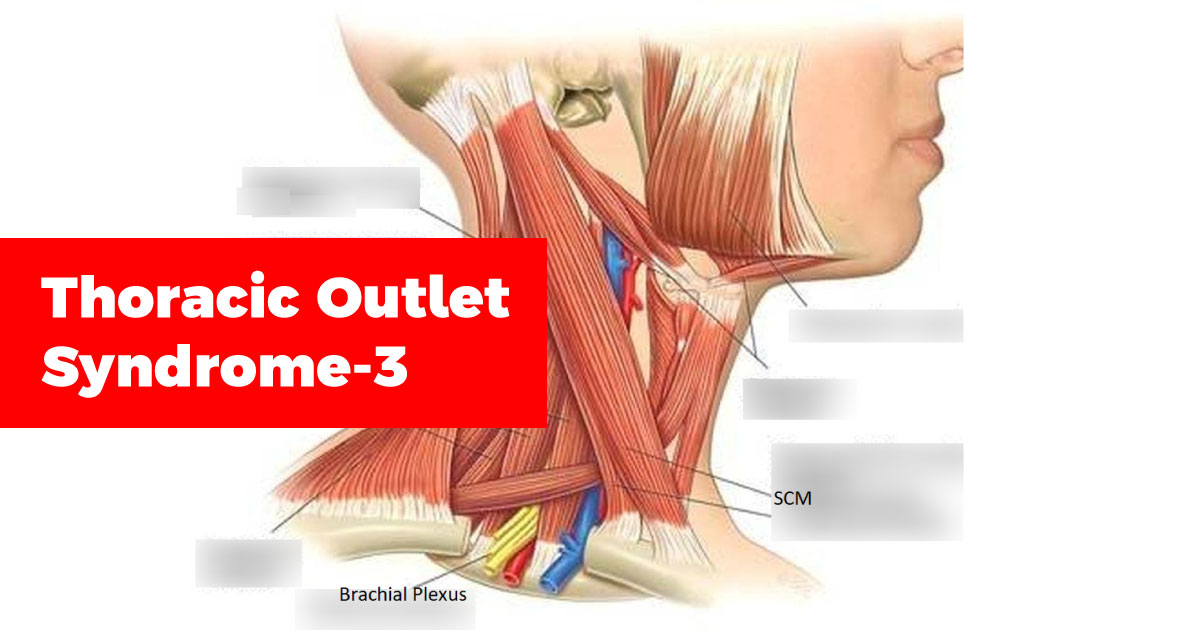Abnormalities in the scalene muscles and TOS

Abnormalities in the scalene muscles can be a contributing factor to the development of thoracic outlet syndrome (TOS). The scalene muscles are located in the neck and play an important role in supporting the head and neck. Examples of abnormalities of the scalene muscles that can cause TOS include:
- Hypertrophy: Hypertrophy is the enlargement of the scalene muscles. Enlarged scalene muscles can compress the nerves and blood vessels in the thoracic outlet and lead to TOS symptoms. Hypertrophy of the scalene muscle is a type of anatomical abnormality that can contribute to the development of thoracic outlet syndrome (TOS). The scalene muscles are located in the neck and are responsible for flexing and rotating the neck. If the scalene muscles become enlarged or hypertrophied, they can compress the nerves and blood vessels in the thoracic outlet and cause TOS symptoms.
Symptoms of TOS associated with hypertrophy of the scalene muscle may include pain, numbness, or tingling in the neck, shoulder, arm, or hand. Other symptoms may include weakness or a feeling of heaviness in the affected arm. These symptoms may worsen with activities that involve overhead movements, such as reaching or lifting.
Hypertrophy of the scalene muscle can be caused by a variety of factors, including repetitive motions, poor posture, or trauma. It can also be associated with medical conditions such as fibromyalgia or thoracic outlet syndrome.
If you have symptoms of TOS associated with hypertrophy of the scalene muscle, it is important to seek medical attention. A healthcare professional can perform a thorough evaluation to determine if your symptoms are related to hypertrophy of the scalene muscle and recommend appropriate treatment. Treatment options may include physical therapy, medication, or surgery, depending on the severity of your symptoms.
- Trigger points: Trigger points are tight, painful knots in the muscle tissue that can refer pain to other areas of the body. Trigger points in the scalene muscles can refer pain to the shoulder, arm, and hand, and can contribute to TOS symptoms. Trigger points in the first cervical rib area can contribute to the development of thoracic outlet syndrome (TOS). Trigger points are areas of muscle tissue that are overly sensitive and can cause pain or discomfort. When trigger points are present in the first cervical rib area, they can compress the nerves and blood vessels in the thoracic outlet and cause TOS symptoms.
Symptoms of TOS associated with trigger points in the first cervical rib area may include pain, numbness, or tingling in the neck, shoulder, arm, or hand. Other symptoms may include weakness or a feeling of heaviness in the affected arm. These symptoms may worsen with activities that involve overhead movements, such as reaching or lifting.
Trigger points in the first cervical rib area can be caused by a variety of factors, including poor posture, repetitive motions, or trauma. They can also be associated with medical conditions such as fibromyalgia or myofascial pain syndrome.
If you have symptoms of TOS associated with trigger points in the first cervical rib area, it is important to seek medical attention. A healthcare professional can perform a thorough evaluation to determine if your symptoms are related to trigger points and recommend appropriate treatment. Treatment options may include trigger point injections, physical therapy, medication, or surgery, depending on the severity of your symptoms.
- Muscle spasms: Muscle spasms in the scalene muscles can also contribute to TOS symptoms by compressing the nerves and blood vessels in the thoracic outlet. Muscle spasms in the scalene muscle can contribute to the development of thoracic outlet syndrome (TOS). The scalene muscles are located in the neck and are responsible for flexing and rotating the neck. When these muscles experience spasms or involuntary contractions, they can compress the nerves and blood vessels in the thoracic outlet and cause TOS symptoms.
Symptoms of TOS associated with muscle spasms in the scalene muscle may include pain, numbness, or tingling in the neck, shoulder, arm, or hand. Other symptoms may include weakness or a feeling of heaviness in the affected arm. These symptoms may worsen with activities that involve overhead movements, such as reaching or lifting.
Muscle spasms in the scalene muscle can be caused by a variety of factors, including poor posture, stress, or trauma. They can also be associated with medical conditions such as fibromyalgia or myofascial pain syndrome.
If you have symptoms of TOS associated with muscle spasms in the scalene muscle, it is important to seek medical attention. A healthcare professional can perform a thorough evaluation to determine if your symptoms are related to muscle spasms and recommend appropriate treatment. Treatment options may include physical therapy, medication, or surgery, depending on the severity of your symptoms. Muscle relaxants may also be used to alleviate the spasms and provide relief.
It is important to seek medical attention if you have symptoms of TOS, especially if you have an abnormality in the scalene muscles. A healthcare professional can perform a thorough evaluation to determine the underlying cause of your symptoms and recommend appropriate treatment. Treatment options may include physical therapy, medication, or surgery, depending on the severity of your symptoms. Stretching and strengthening exercises, massage, and other forms of manual therapy may also be recommended to help alleviate symptoms associated with scalene muscle abnormalities and TOS.
Fibrous bands and TOS
Fibrous bands are another anatomical abnormality that can contribute to the development of thoracic outlet syndrome (TOS). Fibrous bands are thick, fibrous connective tissue that can form in the thoracic outlet, typically between the first rib and the clavicle (collarbone). Examples of fibrous bands that can cause TOS include:
- Costoclavicular syndrome: Costoclavicular syndrome occurs when there is a fibrous band that forms between the first rib and the clavicle, which can compress the nerves and blood vessels in the thoracic outlet. Costoclavicular syndrome (CCS) is a type of thoracic outlet syndrome (TOS) that occurs when there is compression of the neurovascular structures as they pass through the costoclavicular space, which is located between the clavicle and the first rib. Fibrous bands can contribute to the development of CCS by narrowing the costoclavicular space and compressing the nerves and blood vessels that pass through it.
Fibrous bands are bands of connective tissue that can develop between the clavicle and the first rib. These bands can be caused by a variety of factors, including trauma or chronic stress on the area. When fibrous bands develop in the costoclavicular space, they can compress the nerves and blood vessels in the area and cause CCS symptoms.
Symptoms of CCS associated with fibrous bands may include pain, numbness, or tingling in the neck, shoulder, arm, or hand. Other symptoms may include weakness or a feeling of heaviness in the affected arm. These symptoms may worsen with activities that involve overhead movements, such as reaching or lifting.
If you have symptoms of CCS associated with fibrous bands, it is important to seek medical attention. A healthcare professional can perform a thorough evaluation to determine if your symptoms are related to fibrous bands and recommend appropriate treatment. Treatment options may include physical therapy, medication, or surgery, depending on the severity of your symptoms. Surgery may be necessary to remove the fibrous bands and relieve the compression of the nerves and blood vessels in the costoclavicular space.
- Scalenus anticus syndrome: Scalenus anticus syndrome occurs when there is a fibrous band that forms between the scalene muscles and the first rib, which can compress the nerves and blood vessels in the thoracic outlet. Scalenus anticus syndrome, also known as anterior scalene syndrome, is a type of thoracic outlet syndrome (TOS) that occurs when the nerves and blood vessels that pass through the thoracic outlet are compressed by the scalene muscles, specifically the anterior scalene muscle.
The anterior scalene muscle is located in the neck and is responsible for flexing and rotating the neck. When this muscle is overused or experiences spasm or hypertrophy, it can compress the nerves and blood vessels that pass through the thoracic outlet, leading to symptoms of TOS.
Symptoms of scalenus anticus syndrome may include pain, numbness, or tingling in the neck, shoulder, arm, or hand. Other symptoms may include weakness or a feeling of heaviness in the affected arm. These symptoms may worsen with activities that involve overhead movements, such as reaching or lifting.
Treatment for scalenus anticus syndrome typically involves physical therapy to stretch and strengthen the affected muscles and improve posture. Anti-inflammatory medication or muscle relaxants may also be prescribed to alleviate pain and discomfort. In some cases, surgery may be necessary to relieve the compression on the nerves and blood vessels in the thoracic outlet.
It’s important to seek medical attention if you are experiencing symptoms of TOS, as early diagnosis and treatment can prevent further complications and improve outcomes.
Fibrous bands can develop due to a variety of factors, including trauma, inflammation, and repetitive motions. Symptoms of TOS associated with fibrous bands may include pain, numbness, or tingling in the neck, shoulder, arm, or hand. Other symptoms may include weakness or a feeling of heaviness in the affected arm.
If you have symptoms of TOS associated with fibrous bands, it is important to seek medical attention. A healthcare professional can perform a thorough evaluation to determine if your symptoms are related to fibrous bands and recommend appropriate treatment. Treatment options may include physical therapy, medication, or surgery, depending on the severity of your symptoms.
Keywords: Thoracic Outlet Syndrome, TOS, brachial plexus, nerves, anatomy, scalene muscle, cervical rib, first rib, costoclavicular syndrome, Pancoast tumor, neurofibroma, hematomas, Vascular TOS, Neurogenic TOS, Non-specific TOS, Brachial Plexus Neuralgia, treatment options, physical therapy, surgery, occupational therapy, chiropractic care, acupuncture, medications.
Last Revision: 10.03.2023

